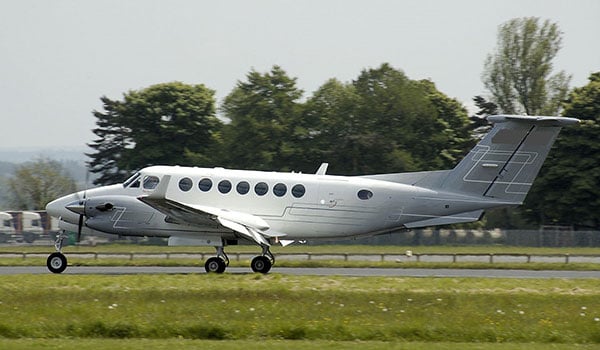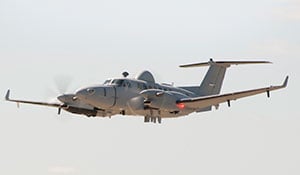
For Commercial Off-the-Shelf (COTS) Aircraft
AMRDEC Tech Talk / By Dr. Robert Vaughan: The Army’s fleet of fixed wing aircraft is a testament to the Army’s ability to purchase Federal Aviation Administration (FAA) type-certificated COTS aircraft, qualify extensive modifications under the Army’s Aviation Engineering Directorate (AED), and maintain these aircraft under unique and challenging operational requirements.

Beech B-300 King Air / AMRDEC AED PHOTO
Aircraft designed and built specifically for military usage require lengthy schedules for design, manufacturing, and testing. A relatively small production quantity results in a high unit cost. When Army operational requirements can be satisfied by modifying a readily available COTS aircraft, the warfighter is provided with a modern system quickly and economically.
The COTS Advantage
Many programmatic, cost, and schedule benefits are realized by selecting COTS aircraft to satisfy Army needs. The key advantage from an airworthiness perspective is that the basic aircraft are delivered with civil airworthiness certification already in place. The airworthiness effort required to produce a qualified Army asset is substantially reduced as compared to the development of a new aircraft because the Army can leverage the work that has already been accomplished by the FAA or another recognized civil airworthiness authority. Airworthiness qualification of the COTS baseline aircraft will be accomplished through review and acceptance of the applicable FAA type certificate (TC) on the pre-existing aircraft type design, along with any applicable Supplemental Type Certificates (STCs) that have been applied to the aircraft. AED also recognizes that COTS aircraft are designed with a specific civilian use in mind. Typical commercial usage for aircraft is to takeoff, climb to cruise altitude, remain at cruise altitude for the majority of flight, then descend to land. However, Army aircraft are modified for a specific military role with usage that is frequently more severe than commercial usage. As a result, maintenance intervals, fatigue lives and inspection intervals could be significantly different than the same aircraft operated in a commercial environment. Through this process of accepting the civil airworthiness certification for the unmodified COTS aircraft and understanding the maintenance impacts for Army usage, AED establishes an airworthiness baseline for a COTS aircraft with the ISR modifications.
 Enhanced Medium Altitude Reconnaissance and Surveillance System (EMARSS)COTS AWC Challenges
Enhanced Medium Altitude Reconnaissance and Surveillance System (EMARSS)COTS AWC Challenges
The primary airworthiness challenge in utilizing a COTS aircraft is the development of a comprehensive Airworthiness Qualification Plan (AQP) to accommodate the installation of primary mission equipment (PME) as well as to substantiate required changes to the aircraft operational envelope or maintenance requirements. The qualification of various equipment and/or Army mission usage will fall into one of three categories for evaluation: Full U.S. Army qualification, Full FAA certification, or a combination of FAA/Army qualification. Certain STC projects require a combined approach to cover all aspects of airworthiness. Once established, AED will develop an AQP that will identify airworthiness requirements that must be met to achieve full qualification. In response, the prime contractor will develop an Airworthiness Qualification Specification (AQS) which will detail their intent to satisfy the AQP. After all stakeholders have agreed to the AQS, the contractor will begin performing the necessary testing, analyses, or demonstrations to substantiate that the modified aircraft is in compliance with the standards and requirements defined in the AQP.
The Army’s Fixed Wing Assets are an example of the effective use of COTS aircraft to meet the requirements for today’s warfighter. However, successful modification of COTS equipment to create an effective Army asset requires strong technical understanding of both the commercial processes of certification and Army qualification processes such that the final product is well-integrated and provides value and confidence to the user. Recognizing that all stakeholders must be fully engaged and committed during the Airworthiness Qualification Plan development and implementation is the key to success.
Dr. Robert Vaughan is the Fixed Wing Systems Branch Chief for the Aviation Engineering Directorate of the U.S. Army Aviation and Missile Research, Development, and Engineering Center located at Redstone Arsenal, AL.
Beech B-300 King Air / AMRDEC AED PHOTO
Enhanced Medium Altitude Reconnaissance and Surveillance System (EMARSS)








